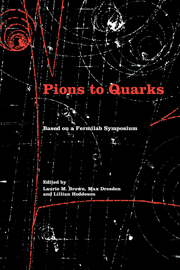Book contents
- Frontmatter
- Contents
- List of contributors
- Foreword by Leon M. Lederman
- Editors' acknowledgments
- Photographs of the symposium
- List of abbreviations
- List of notation
- I Introduction
- II Particle discoveries in cosmic rays
- III High-energy nuclear physics
- IV The new laboratory
- V The strange particles
- VI Weak interactions
- VII Weak interactions and parity nonconservation
- 29 The nondiscovery of parity nonconservation
- 30 K-meson decays and parity violation
- 31 The τ–θ puzzle: an experimentalist's perspective
- 32 The early experiments leading to the V–A interaction
- 33 Midcentury adventures in particles physics
- VIII The particle physics community
- IX Theories of hadrons
- X Personal overviews
- Name index
- Subject index
31 - The τ–θ puzzle: an experimentalist's perspective
Published online by Cambridge University Press: 07 May 2010
- Frontmatter
- Contents
- List of contributors
- Foreword by Leon M. Lederman
- Editors' acknowledgments
- Photographs of the symposium
- List of abbreviations
- List of notation
- I Introduction
- II Particle discoveries in cosmic rays
- III High-energy nuclear physics
- IV The new laboratory
- V The strange particles
- VI Weak interactions
- VII Weak interactions and parity nonconservation
- 29 The nondiscovery of parity nonconservation
- 30 K-meson decays and parity violation
- 31 The τ–θ puzzle: an experimentalist's perspective
- 32 The early experiments leading to the V–A interaction
- 33 Midcentury adventures in particles physics
- VIII The particle physics community
- IX Theories of hadrons
- X Personal overviews
- Name index
- Subject index
Summary
It is a great pleasure to contribute to this volume on the history of particle physics in the 1950s as one of the experimental physicists who participated in the establishment of the puzzle, one that eventually was so constrained by experiment that it had to have a far-from-trivial resolution.
The period I shall discuss starts in the summer and fall of 1953, when the properties of what we now call K mesons were being established, and concludes in the summer of 1956 with the publication of the Lee–Yang paper on parity violation. What always paces the rate of discovery is the development of new instruments – new devices for probing phenomena, either with a new level of precision or by extending the range of observation into realms never before explored. The growth of our knowledge of K mesons is a superb example of this. The new knowledge was acquired at the rate at which new devices were invented, developed, and applied to the problems at hand. Figure 31.1 gives my impression of some of the important instrument developments and the time when they became useful laboratory tools. Chronological lists like this one have appeared elsewhere. Perhaps the only thing new on the present list is the development of the end-window phototube. While in itself it seems like a minor thing, it had a tremendous impact in the utility of both scintillation and Cerenkov counters. All of us who tried to design a Cerenkov counter using the old 931-A or 1P21 phototubes will understand what I mean.
- Type
- Chapter
- Information
- Pions to QuarksParticle Physics in the 1950s, pp. 458 - 463Publisher: Cambridge University PressPrint publication year: 1989



